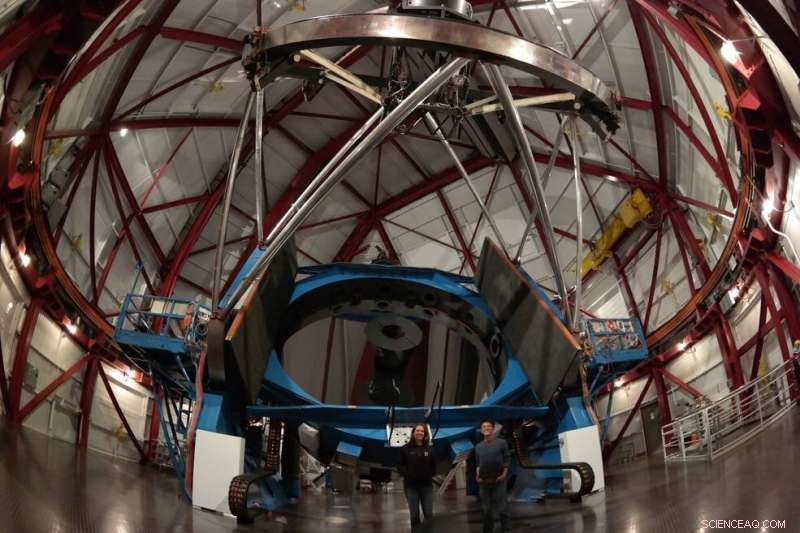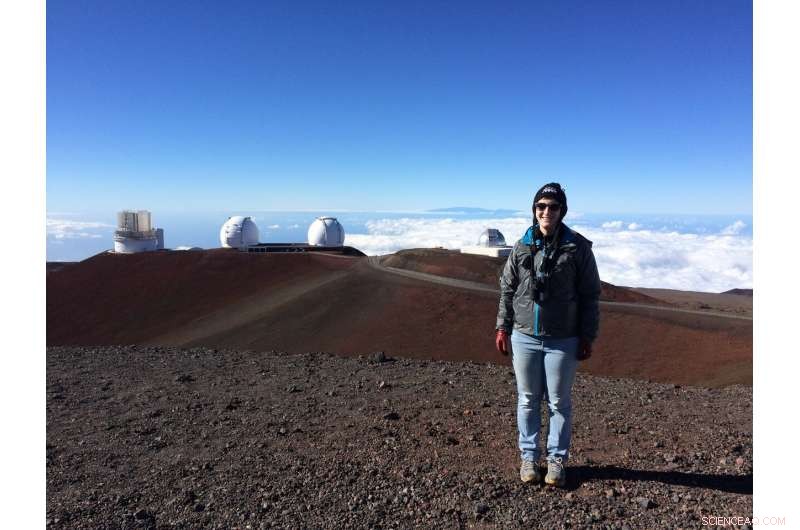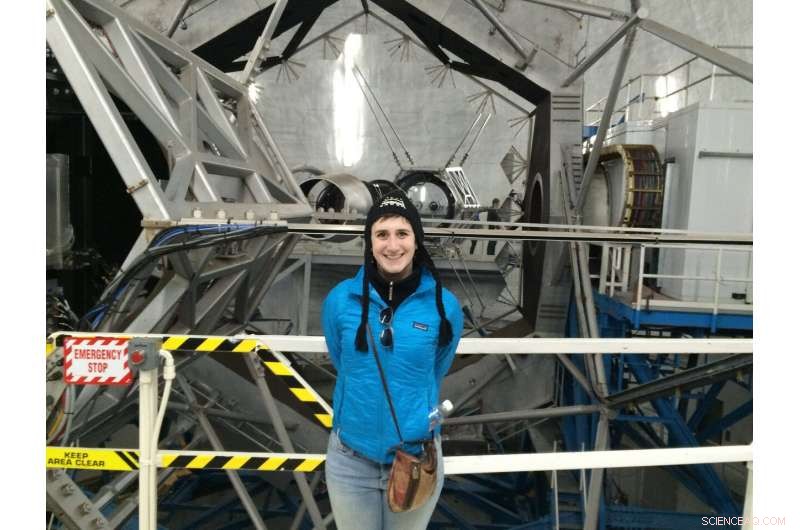
Astrônomos Johanna Teske e Alex Ji no telescópio Magellan II no Chile. Crédito:Cindy Hunt
Enquanto o líquido rosa escorria em torno de seus sapatos, a astrônoma Johanna Teske começou a se sentir mal. Ela estava procurando por novos planetas com o Planet Finder Spectrograph, um instrumento astronômico semelhante a um refrigerador de tamanho industrial montado no telescópio Magellan II. Uma noite em outubro de 2018, uma mangueira que leva ao estouro do instrumento, fazendo com que o líquido refrigerante rosa derrame em partes sensíveis do instrumento e na plataforma ao redor. A busca de Teske seria arruinada?
Teske usa o telescópio Magellan II no Observatório Las Campanas, no Chile, para localizar planetas fora do nosso sistema solar, ou exoplanetas, e descubra do que eles são feitos. A data, mais de 4, 000 exoplanetas foram descobertos, mas a ciência mostrou que deve haver bilhões, ou mesmo trilhões, em nossa galáxia sozinho. O mais novo caçador de planetas da NASA, o Transiting Exoplanet Survey Satellite (TESS), procura possíveis planetas em torno de estrelas brilhantes próximas.
Muitas equipes de cientistas em todo o mundo estão vasculhando os dados do TESS, escolher estrelas que poderiam ser promissoras para observar do solo e reservar tempo em poderosos telescópios para acompanhar novos candidatos a planetas. A corrida começou para ver quais desses sinais TESS representam algum tipo de impostor, e que apontam para novos mundos reais.
Como NASA Hubble Postdoctoral Fellow no Carnegie Observatories em Pasadena, Califórnia, Teske estava animado para se juntar a esta corrida. Seu grupo recebeu financiamento da NASA para procurar planetas com três vezes o raio da Terra ou menos, que incluiria planetas estranhos chamados "super-Terras". Acredita-se que as super-Terras sejam rochosas como a Terra, mas um pouco maior que nosso planeta. Em outubro de 2018, Teske e colegas começaram as observações de acompanhamento do TESS pela primeira vez. Mas no meio de sua corrida de duas semanas, durante sua noite mais clara, o tubo estourou.
O cano poderia ser consertado e a bagunça limpa logo o suficiente para economizar o resto do tempo de observação de Teske? Ela e sua equipe coletariam dados valiosos sobre exoplanetas?
Por que a caça ao planeta da Terra é essencial
A noite dramática de Teske no Chile não é típica, mas ilustra como a busca por exoplanetas do solo pode ser complicada por questões terrenas. Além do problema mecânico ocasional, os astrônomos devem lutar contra o vento, chuva, neve, nuvens e turbulência atmosférica geral - qualquer uma das quais poderia arruinar uma noite inteira de observação do céu. A Lua também apresenta desafios:embora as estrelas TESS sejam geralmente brilhantes e possam ser observadas durante o "tempo brilhante" - isto é, quando a Lua está cerca de três quartos cheia - os astrônomos olhando para estrelas muito fracas ou outras galáxias devem esperar pelo "tempo escuro", quando há pouco ou nenhum luar. E, já que os astrônomos só podem observar à noite, eles precisam renunciar ao sono durante as horas de preciosa escuridão.
Mas os telescópios terrestres são essenciais para confirmar a existência de planetas que o TESS e outros telescópios espaciais encontram, e para aprender mais sobre eles. TESS, como o caçador de planetas baseado no espaço Kepler, cuja missão terminou em 2018, encara estrelas por períodos de tempo, medindo o quão brilhante é a estrela a cada poucos minutos durante semanas de cada vez. Uma queda nesse brilho pode representar um evento chamado de "trânsito, "em que um planeta passa na frente de sua estrela. Mas o mergulho poderia muito bem vir de outra estrela, or be another kind of transient phenomenon occurring on the star or within the detector electronics.
Scientists must turn to ground-based telescopes to figure this out. When Kepler was sending back data suggesting thousands of new planets, astronomers organized themselves to follow up on them, também. The results led to the realization that there are more planets than stars in the Milky Way.
"The brightness measurements from the spacecraft are only the first step, " said David Ciardi, astronomer at the California Institute of Technology, Pasadena. "You need a dedicated ground program to vet and clarify what you see. Without the ground data, you can't understand what TESS has seen."
In some cases, there may be data collected from a star in years past that contain the information necessary to confirm a planet candidate—such as in the case of TESS's first confirmed planet Pi Mensae c. De outra forma, astronomers need fresh observations to learn all they can about these alien worlds.
And because they are accessible to human hands, ground-based telescopes can be upgraded, fixed and re-tooled much more easily than space observatories. In some cases, ground-based telescopes have higher resolution for taking images of stars than space telescopes.
"We have a lot of questions about every single planet, " said Lauren Weiss, the Parrent Postdoctoral Fellow at the University of Hawaii at Manoa. "There are a lot of small planets that we're really excited about, but in order to answer all of these questions, we have to use a variety of new tools and techniques."

Astronomer Lauren Weiss at the W. M. Keck Observatory in Hawaii. Credit:B.J. Fulton
Ground-based follow-up is more critical than ever now that astronomers are gearing up for NASA's upcoming James Webb Space Telescope, which will study exoplanet atmospheres with greater sensitivity than any observatory yet. Webb will look for the fingerprints of chemicals in exoplanet atmospheres, including those allowing life as we know it to thrive. But because Webb will target many different scientific questions about the universe, it will only have a portion of its time for looking at exoplanets. Astronomers need to start finding the most promising targets now so that they're ready to explore them further as soon as Webb starts operating.
Mas primeiro, scientists need to be sure those planets are really there.
What Ground-Based Telescopes Do
One of the first facts a scientist needs to know about a possible exoplanet is:Which star does the planet orbit? This fundamental puzzle piece isn't immediately obvious from telescope data because all astronomers can see are individual pixels from the telescope camera, each corresponding to an area of the sky. If two stars appear extremely close to each other in these data, it may not be obvious which star seems to be dimming because of a transiting planet.
"The ground-based efforts can determine which star is the source of the signal, " said Knicole Colon, astronomer at NASA's Goddard Space Flight Center in Greenbelt, Maryland. "That's absolutely a major part of the ground-based follow-up:Which star is the host?"
Então, there's a separate process of getting the mass of the planet. No one can put a planet on a scale. But a planet's mass is often determined through the "radial velocity method", or looking at how the star wobbles ever so slightly in response to the gravity of its planets. Atualmente, only ground-based telescopes are capable of exoplanet radial velocity measurements. Carnegie's Planet Finder Spectrograph, which Teske uses at Las Campanas in Chile, is just one instrument that can determine a planet's mass. The forthcoming NEID spectrograph, a collaboration between NASA and the National Science Foundation, at Kitt Peak Observatory in Arizona, is another example.
The mass of a planet is different from its size, which refers to its diameter. Scientists measure diameter by looking at how much the brightness of the host star dims during the transit.
Combining the size and the mass of the planet, scientists can determine its density—a big indicator of whether it is rocky, like Earth, gaseous, like Jupiter, or something in between, which would be unlike any of the planets we have in our solar system.
Astronomers also use Earth-based telescopes to thoroughly study the stars themselves to determine planet properties. Any size or mass measurement of a planet can only be calculated relative to the size and mass of its host star. And if the star is part of a double-star or multi-star system, that could change the calculations entirely unless astronomers can determine the fraction of light originating from other nearby stars, and factor it into their calculations.
With so many different properties of star and planet observations to consider, it often takes large groups of scientists working with different instruments to arrive at even a basic understanding of a planetary system.
"That's why these teams are so big, " Weiss said. "Each of us has to address a very specific question, or set of questions, related to the validity of the planetary hypothesis, and the fundamental properties of the star and planet."
A planet that Weiss helped discover, TOI-197b (also called HD 221416b), is a particularly good example of how a giant collaboration of people using observatories in space and on the ground can paint a picture of a new world. The study announcing it to the world, published in April 2019, was authored by more than 100 people representing five different continents. Astronomers found out a lot about the age and radius and mass of the star because of the special way they have been able to examine its properties.
"The star is ringing like a bell from internal pressure waves and gravity waves inside the star, " Weiss said. The study of these waves, called asteroseismology, is a powerful tool for characterizing a star.

Astronomer Lauren Weiss looks at planets outside our solar system using the Keck Telescope in Hawaii. Credit:B.J. Fulton
Multiple observatories worldwide including Keck Observatory at Mauna Kea in Hawaii, where Weiss was situated, contributed observations. Dan Huber, the lead author, wrangled all of the different datasets together. Ashley Chontos at the University of Hawaii created a model to reconcile both the transit and radial velocity measurements. By matching their model to the observations, astronomers were able to put together a picture of the planet that could explain all of these different signals seen in all of the different telescopes.
Astronomers found that, at 63 times the mass of Earth, this planet is a little bit denser than Saturn. But they call it a "hot Saturn" because its orbit around its star is only 14 days (by contrast, Saturn makes a loop around our Sun every 29 years). There is nothing quite like it in our solar system.
A New Planet, and Even Another
Então, what happened with Teske's planet search after the burst pipe incident at Las Campanas? The search for new planets motivated her to snap into action. "Pretty quickly I moved into 'how do we fix' this mode, " she recalled. "It was a big team effort for sure."
Felizmente, the observatory staff was able to resolve the issue in a few hours. After they finished mopping and carefully checked over the instrument, Teske and colleagues resumed their exploration of exoplanets that very night, and continued for the rest of their scheduled week. Despite overnight observing for about two weeks during the telescope run, Teske didn't go home to Pasadena afterwards—she boarded a plane for Washington, D.C., where she ran a marathon.
Their observations from that trip helped scientists determine the mass of a planet around a star called HD 21749 or GJ 143. This so-called "sub-Neptune" planet is about 2.6 times the diameter of Earth and likely gaseous, but smaller than any gas giant in our solar system.
Combining the Las Campanas observations with data from TESS and archival data from the HARPS instrument at La Silla, Chile, astronomers were able to confirm this exoplanet and determine its mass, which is more than 20 times that of Earth.
"While we were looking at the data for that planet, we found that there is another planet in the same system around the same star; it's about Earth's size, " said Diana Dragomir, also a NASA Hubble Postdoctoral Fellow at MIT who was the first author on a study of this system, and part of the observing team with Teske at Las Campanas. "It's a nice demonstration that TESS can indeed find Earth-size planets."
During the same observing run, Teske and colleagues also got some measurements of Pi Mensae c, the very first planet confirmed in TESS data, that may help get a better handle on its mass. With more data left to sift through, discoveries may be yet to come from that same observing run in October 2018.
Since TESS recently turned its gaze to the northern hemisphere of the sky, the Chilean telescopes will be out of range for much of the next batch of data. That gives Teske and collaborators time to go back through what they've done so far, and figure out which southern TESS stars they want to keep following over the next two years. Their goal is to find out more about super-Earth and sub-Neptune exoplanet populations by establishing masses for such planets as precisely as possible.
At nearly 8, 000 feet up, Las Campanas isn't high enough to make Teske feel dizzy from the altitude, but high enough that she might get out of breath from walking fast. A variety of wildlife, like foxes and rabbit-like animals called viscachas, sometimes approach the dome as Teske and her collaborators explore the galaxy. She knew she wanted to be an astronomer around age 10 or 11 when she saw the movie "Contact, " based on the book by Carl Sagan, and related to the main character's drive and curiosity. Hoje, observing in Chile is one of Teske's favorite parts of her job.
"I am getting to see things that no one else is seeing. It's quiet, and it's just me and the stars, " Teske said. "I hesitate to use the word 'magical'—but it's analogous to that."